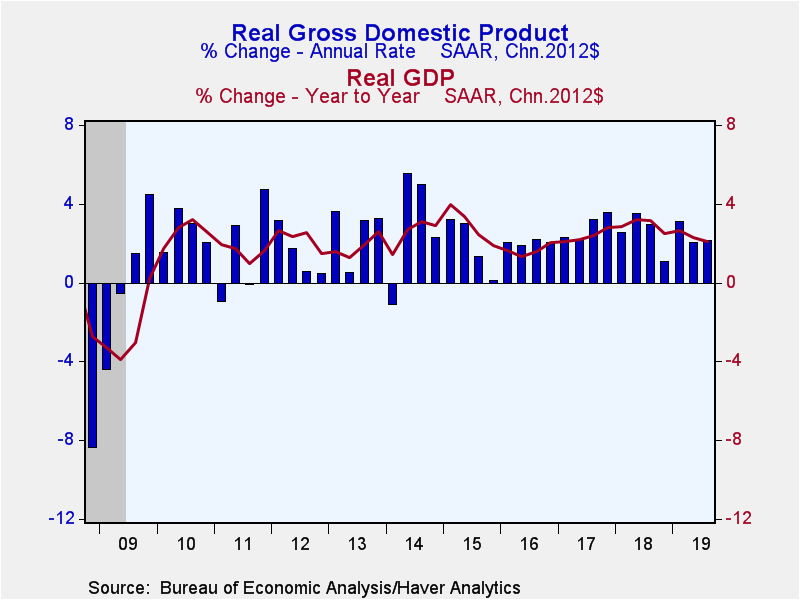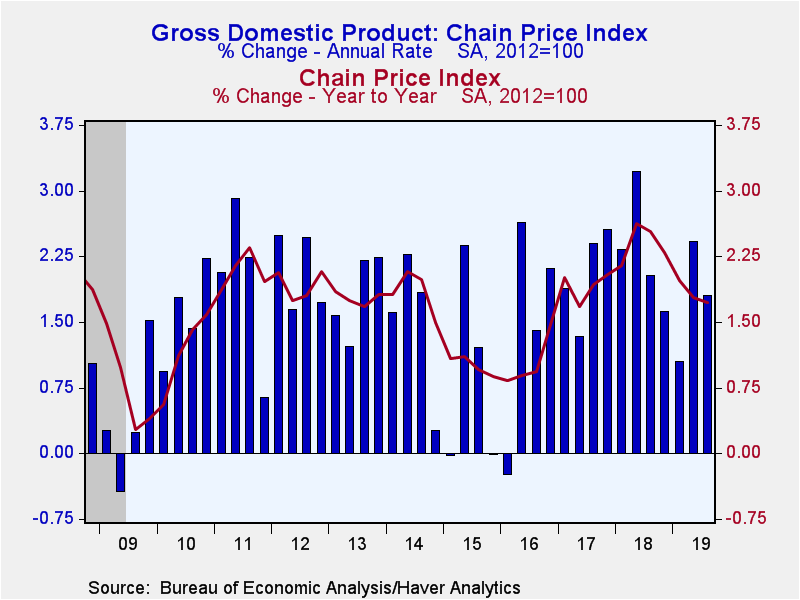 Global| Nov 27 2019
Global| Nov 27 2019U.S. GDP Growth Revised Up, but Corporate Profits Decline
by:Tom Moeller
|in:Economy in Brief
Summary
Economic growth during Q3'19 was revised higher to 2.1% (2.1% y/y) from the advance estimate of a 1.9% rise. An unrevised reading of 1.9% rise had been expected in the Action Economics Forecast Survey. The increase roughly matched the [...]
Economic growth during Q3'19 was revised higher to 2.1% (2.1% y/y) from the advance estimate of a 1.9% rise. An unrevised reading of 1.9% rise had been expected in the Action Economics Forecast Survey. The increase roughly matched the Q2'19 gain which were weakest rates of growth since the end of 2016.
Corporate profits after tax fell 0.6% last quarter (-0.5% y/y) following a 3.3% Q2 increase. It was the third decline in the last four quarters. Before-tax profits with CCA and IVA improved 0.2% (-0.8% y/y). Domestic nonfinancial profits rose 0.7% (-4.9% y/y) while financial sector earnings fell 2.4% (+8.2% y/y). Foreign sector profits increased 1.2% (6.5% y/y).
The upward revision to GDP growth last quarter was due to an increase in inventories which now are estimated to have added 0.2 percentage points to growth rather than subtracting 0.1 percentage points. Deterioration in the foreign trade deficit subtracted slightly from growth rather than having no effect. Exports rose 0.9% (0.2% y/y) after a 5.7% decline while imports increased 1.5% (0.9% y/y) following little change.
Growth in domestic final sales was unrevised at 2.0% (2.2% y/y) after a 3.6% Q2 gain. Growth in personal spending held at 2.9% (2.5% y/y) and remained roughly steady with growth during the last three years. Durable goods spending growth was upwardly revised to 8.3% (5.6% y/y) after strengthening 13.0% in the second quarter. Growth in purchases of nondurable goods was little changed at 4.3% (3.6% y/y) after a 6.5% jump. Spending on services improved an unrevised 1.7% both q/q and y/y following a 2.8% Q2 rise.
Fixed business investment also was little revised and declined 2.7% (+1.3% y/y), down for the second consecutive quarter. Spending on structures fell 12.0% (-7.3% y/y) which followed an11.1% drop. Equipment investment also declined by an unrevised 3.8% (+1.0% y/y), the first material quarterly decline in three years. It was prompted by a 6.3% weakening (+1.8% y/y) in information processing equipment investment which was the largest quarterly decline in roughly eight years. Intellectual property product investment rose 5.1% (7.8% y/y) as software spending rose by roughly one-third (41.4% y/y).
Growth in residential investment was unchanged at 5.1% (-1.0% y/y), the first increase since Q4'17.
Government spending growth was lessened to 1.6% (2.2% y/y) and remained less than half the prior quarter's increase. The slowdown occurred as federal government spending rose 3.4% (3.7% y/y) following an 8.3% improvement. Nondefense outlays strengthened 5.1% (2.5% y/y) last quarter after a 16.1% jump. Defense spending rose 2.2% (4.6% y/y), the weakest increase since Q1'18. Spending by state & local governments improved a lessened 0.5% (1.3% y/y) following a 2.7% rise.
The GDP price index rose 1.8% (1.7% y/y), revised from 1.7%, after a 2.4% gain during Q2. The PCE price index rose 1.5% (1.4% y/y) after a 2.4% rise, while prices excluding food & energy improved 2.1% (1.7% y/y). The business fixed investment price index rose 0.5% and a fairly steady 1.0% y/y. The residential investment price index strengthened 3.4% but the y/y increase slowed to 2.5%, the weakest growth since early 2016.
The GDP figures can be found in Haver's USECON and USNA database. USNA contains virtually all of the Bureau of Economic Analysis' detail in the national accounts. Both databases include tables of the newly published not seasonally adjusted data. The Action Economics consensus estimates can be found in AS1REPNA.
| Chained 2012 $ (%, AR) | Q3'19 (Second Estimate) | Q3'19 (Advance Estimate) | Q2'19 | Q1'19 | Q3'19 Y/Y | 2018 | 2017 | 2016 |
|---|---|---|---|---|---|---|---|---|
| Gross Domestic Product | 2.1 | 1.9 | 2.0 | 3.1 | 2.1 | 2.9 | 2.4 | 1.9 |
| Inventory Effect (%-point) | 0.2 | -0.1 | -0.9 | 0.5 | -0.1 | 0.1 | 0.1 | -0.3 |
| Final Sales | 2.0 | 2.0 | 3.0 | 2.6 | 2.1 | 2.8 | 2.3 | 2.2 |
| Foreign Trade Effect (%-point) | -0.1 | 0.0 | -0.7 | 0.7 | -0.1 | -0.2 | -0.2 | -0.2 |
| Domestic Final Sales | 2.0 | 2.0 | 3.6 | 1.8 | 2.2 | 3.0 | 2.5 | 2.4 |
| Personal Consumption Expenditure | 2.9 | 2.9 | 4.6 | 1.1 | 2.5 | 3.0 | 2.6 | 2.7 |
| Nonresidential Fixed Investment | -2.7 | -3.0 | -1.0 | 4.4 | 1.3 | 6.4 | 4.4 | 0.7 |
| Residential Investment | 5.1 | 5.1 | -2.9 | -1.1 | -1.0 | -1.5 | 3.5 | 6.5 |
| Government Spending | 1.6 | 2.0 | 4.8 | 2.9 | 2.2 | 1.7 | 0.7 | 1.8 |
| Chain-Type Price Index | ||||||||
| GDP | 1.8 | 1.7 | 2.4 | 1.1 | 1.7 | 2.4 | 1.9 | 1.0 |
| Personal Consumption Expenditure | 1.5 | 1.5 | 2.4 | 0.4 | 1.4 | 2.1 | 1.8 | 1.0 |
| Less Food & Energy | 2.1 | 2.2 | 1.9 | 1.1 | 1.7 | 1.9 | 1.6 | 1.6 |
| Nonresidential Investment | 0.5 | 0.6 | 2.0 | 1.6 | 1.0 | 1.4 | 1.0 | -0.9 |
| Residential Investment | 3.4 | 3.3 | 1.7 | 2.6 | 2.5 | 5.6 | 4.5 | 3.5 |
Tom Moeller
AuthorMore in Author Profile »Prior to joining Haver Analytics in 2000, Mr. Moeller worked as the Economist at Chancellor Capital Management from 1985 to 1999. There, he developed comprehensive economic forecasts and interpreted economic data for equity and fixed income portfolio managers. Also at Chancellor, Mr. Moeller worked as an equity analyst and was responsible for researching and rating companies in the economically sensitive automobile and housing industries for investment in Chancellor’s equity portfolio. Prior to joining Chancellor, Mr. Moeller was an Economist at Citibank from 1979 to 1984. He also analyzed pricing behavior in the metals industry for the Council on Wage and Price Stability in Washington, D.C. In 1999, Mr. Moeller received the award for most accurate forecast from the Forecasters' Club of New York. From 1990 to 1992 he was President of the New York Association for Business Economists. Mr. Moeller earned an M.B.A. in Finance from Fordham University, where he graduated in 1987. He holds a Bachelor of Arts in Economics from George Washington University.












